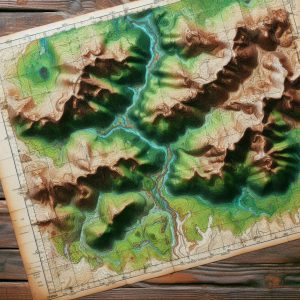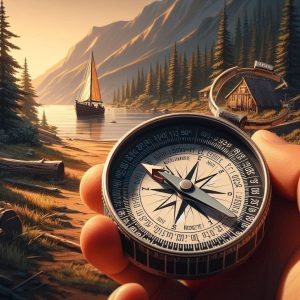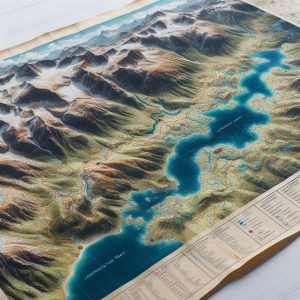Boost Your Wilderness Navigation Skills: Ultimate Guide for Adventurers Embracing Non-GPS Techniques
Mastering the essential skills of wilderness navigation without the aid of modern technology may seem daunting at first. However, developing your proficiency in map and compass navigation can be a remarkable asset, greatly enhancing your outdoor experiences. At the core of successful navigation is a deep understanding of your natural surroundings and the ability to accurately pinpoint your location relative to your desired destination. A map serves as an intricate two-dimensional representation of the terrain, while a compass provides a dependable method for orienting yourself according to the cardinal directions: north, south, east, and west. By refining your skills with these essential tools, you can venture into the wilderness with confidence, free from reliance on technological devices.
To initiate your navigation journey, immerse yourself in the diverse symbols and scales illustrated on a map; these components are crucial for accurately interpreting the physical landscape. A thorough understanding of how to read contour lines that represent elevation changes is imperative, as it enables you to identify hills, valleys, and other geographical features that may influence your chosen route. Additionally, becoming skilled in compass usage is equally important, as it empowers you to navigate effectively through the wilderness without depending on GPS devices.
The compass needle consistently points toward magnetic north, allowing you to align your map with the actual landscape. To accomplish this, hold the compass level in your hand and rotate the map until the magnetic north indicated by the compass aligns with the north displayed on the map. This fundamental technique, often referred to as “orienting the map,” is essential for maintaining accuracy in your navigation efforts and ensuring you remain on the correct path.
Once the map is correctly oriented, you can use the compass to take bearings that will guide your course of travel. By skillfully combining these two powerful navigational instruments—the map and the compass—you will confidently explore unfamiliar terrains, ensuring that you stay on track, even without the aid of modern technological tools.
Key Principles for Effective Outdoor Navigation Mastery
- Gaining expertise in map and compass navigation is vital for anyone participating in wilderness exploration or various outdoor activities.
- Topographic maps offer intricate details about the terrain, elevation, and natural features, all of which are essential for successful navigation.
- A compass not only helps determine direction but also aids navigation by aligning with the map's orientation and understanding magnetic north.
- Natural landmarks and indicators, such as distinctive rock formations or unique tree patterns, can serve as invaluable navigational aids when a map or compass isn't available.
- Estimating distance and travel time is crucial for planning and executing an effective navigation strategy in wilderness environments.
 The Essential Importance of Topographic Maps in Wilderness Navigation
The Essential Importance of Topographic Maps in Wilderness Navigation
Topographic maps are invaluable resources for anyone planning a wilderness expedition. They provide extensive information about the physical characteristics of the landscape, using contour lines to represent changes in elevation. This visual representation allows you to anticipate the challenges posed by the terrain. Each contour line connects points of equal elevation, and the spacing between these lines indicates whether the slope is steep or gentle, equipping you with crucial knowledge for effective navigation.
Understanding Contour Lines and Map Symbols for Enhanced Navigation
As you explore a topographic map, it's important to carefully examine the patterns formed by contour lines; closely spaced lines indicate steep terrain, while widely spaced lines represent flatter areas. This understanding will enable you to anticipate potential obstacles along your route, allowing for informed navigation decisions. Additionally, topographic maps are filled with symbols that represent various landmarks, including rivers, roads, trails, and different types of vegetation. Familiarizing yourself with these symbols is foundational for effective navigation and ensures you can utilize the map to its fullest potential.
Mastering Navigation Techniques with Topographic Maps
For instance, blue lines typically indicate the presence of water bodies, such as streams or lakes, while green areas may signify forests or dense vegetation. By correlating these symbols with your surroundings, you can verify your location and make necessary adjustments to your route. Moreover, topographic maps often include grid lines that help you pinpoint coordinates, allowing for greater precision in navigation. By mastering the intricacies of topographic maps, you will not only deepen your appreciation for the landscape but also enhance your overall navigational skills in the wild.
 Leveraging the Compass for Accurate Directional Navigation
Leveraging the Compass for Accurate Directional Navigation
A compass is an indispensable tool for any adventurer, offering crucial assistance in directional navigation, particularly when traversing unfamiliar landscapes. To effectively use a compass, begin by holding it level in front of you and allowing the needle to stabilize. The needle will point toward magnetic north, which may differ slightly from true north due to magnetic declination—the angle between magnetic north and true north varies based on your geographical location.
Before embarking on your journey, it is essential to determine the local declination and adjust your compass accordingly. This adjustment is vital for maintaining accurate bearings, ensuring you stay on course throughout your adventure. Once your compass is calibrated for declination, you can proceed to take a bearing that will guide your direction of travel.
To take a bearing, identify a landmark you wish to navigate toward and rotate the compass housing until the orienting arrow aligns with the magnetic needle. The degree reading on the compass dial that aligns with the index line indicates your bearing. As you move toward your destination, regularly check your bearing to ensure you remain on the correct path.
If you notice that you have deviated from your intended course, simply reorient your compass and adjust your path as needed. By mastering these techniques, you will gain confidence in using a compass as a reliable navigational tool during any outdoor adventure.
 Utilizing Natural Landmarks and Environmental Signs for Effective Wilderness Navigation
Utilizing Natural Landmarks and Environmental Signs for Effective Wilderness Navigation
While maps and compasses are vital navigational tools, observing natural landmarks and cues can significantly enhance your ability to navigate the wilderness effectively. Distinctive features such as mountains, rivers, or unique trees can serve as invaluable reference points when traversing unfamiliar terrain. For example, if you are aware that a specific mountain lies to the east of your starting point, you can use it as a reliable guide to ensure you’re heading in the correct direction.
Furthermore, familiarizing yourself with the unique characteristics of your surroundings will assist in forming mental maps, allowing you to navigate without solely relying on tools. In addition to prominent landmarks, pay close attention to natural indicators that may suggest direction or changes in terrain. The sun's position can be a helpful guide; in the northern hemisphere, the sun rises in the east and sets in the west, providing a general sense of direction throughout the day.
Moreover, observing moss growth on trees—often more abundant on the north side—can provide valuable clues about orientation in dense forests. Animal trails can also offer directional hints; many animals follow established paths that can lead you toward water sources or other significant landmarks. By enhancing your ability to interpret these natural signs, you will refine your skills in navigating diverse environments.
Accurately Estimating Distance and Travel Time for Effective Wilderness Navigation
Being able to accurately estimate distance and travel time is critical for successful navigation in wilderness areas. Understanding how far you have traveled and the anticipated time to reach your destination allows for better planning and helps avoid unexpected challenges. One practical technique for estimating distance is pacing—counting your steps as you walk.
On average, an adult’s stride measures approximately 2.5 feet; therefore, by counting your steps over a known distance, you can estimate how far you've traveled based on your pace. Additionally, consider the type of terrain and elevation changes when estimating travel time. For instance, traversing flat ground typically allows for quicker movement compared to navigating steep hills or rocky paths.
A common guideline suggests that you can cover roughly three miles per hour on flat terrain, but this estimate should be adjusted significantly when facing challenging landscapes. By accounting for these variables and adjusting your expectations accordingly, you will be better prepared for your journey and more adept at managing your time effectively.
Creating a Thoughtful Wilderness Route and Navigation Strategy
Designing Your Wilderness Route for Optimal Navigation Success
Developing an effective navigation strategy is essential before embarking on any wilderness adventure. Begin by analyzing topographic maps of the area you plan to explore, identifying potential routes based on notable landmarks, existing trails, and accessible water sources. As you construct your route, consider factors such as elevation changes and terrain difficulty; ensuring that your plan is realistic and achievable is of utmost importance.
Preparing for Unforeseen Obstacles and Weather Variability
While planning your route, it’s wise to consider alternative paths in case you encounter unexpected obstacles or sudden changes in weather conditions. Having multiple options will grant you greater flexibility during your journey and enhance your overall safety. This adaptability is crucial for a successful and enjoyable wilderness experience, empowering you to navigate any challenges that may arise seamlessly.
Formulating a Comprehensive Navigation Strategy
Once you've outlined potential routes, create a detailed navigation plan that includes key waypoints. Mark these waypoints on your map and, if possible, note their coordinates, allowing you to track your progress as you navigate through the wilderness. Additionally, incorporate estimated travel times between waypoints and identify any potential hazards that may arise along your chosen route.
Ensuring a Safe and Rewarding Outdoor Experience Through Planning
Thorough planning and anticipating challenges significantly enhance your chances of reaching your destination while enjoying a safe and fulfilling outdoor experience. A well-organized navigation strategy is vital for a successful wilderness adventure, ensuring that you can explore the great outdoors with confidence and assurance.
 Employing Emergency Navigation Techniques for Unforeseen Scenarios
Employing Emergency Navigation Techniques for Unforeseen Scenarios
Despite meticulous planning and preparation, unexpected circumstances may arise during outdoor adventures that necessitate employing emergency navigation techniques. One crucial skill is the ability to backtrack; if you find yourself lost or disoriented, retracing your steps can often lead you back to familiar territory. To execute this effectively, pay close attention to distinctive landmarks or features along your route, which can serve as reference points during your return journey.
Another invaluable technique is celestial navigation, particularly useful when visibility allows—especially on clear nights or sunny days when stars or celestial bodies are visible. Familiarizing yourself with prominent constellations, such as the North Star (Polaris) in the northern hemisphere, can offer guidance, as it remains relatively fixed in position while other stars shift. By locating Polaris and determining its angle above the horizon, you can ascertain true north without the need for a compass or map.
If you have a wristwatch or smartphone available as a backup, utilizing it alongside celestial navigation can further enhance your sense of direction during emergencies, helping you maintain your orientation even in challenging situations.
Elevate Your Wilderness Navigation Skills: Effective Strategies for Continuous Improvement
Improving your wilderness navigation skills requires dedication and consistent practice, but the rewards can greatly enrich your outdoor experiences. One effective strategy is to join local hiking groups or outdoor clubs, where members can share their knowledge and experiences related to navigation techniques. Engaging with experienced navigators can provide valuable insights into best practices while offering hands-on learning opportunities across a variety of terrains.
Another advantageous approach involves regularly practicing with maps and compasses in diverse environments—whether in urban settings or remote wilderness areas—to build your confidence in these essential skills. Set aside time for solo excursions where you intentionally navigate without technological aids; this method will reinforce your abilities while allowing you to connect more deeply with nature. Furthermore, consider maintaining a navigation journal to document routes taken, challenges faced, and lessons learned during each adventure; this reflective practice will not only enhance your skills but also deepen your appreciation for navigating diverse landscapes.
By embracing these techniques and continuously refining your skills in map reading, compass usage, natural observation, distance estimation, route planning, emergency strategies, and sharing practical experiences with others, you will evolve into a more self-assured navigator, capable of thriving in any wilderness environment, even without the support of technology.
Common Questions About Wilderness Navigation Techniques
What does wilderness navigation encompass?
Wilderness navigation encompasses the skills and techniques necessary to determine and maintain a route through natural, often remote, and undeveloped areas. It involves utilizing various tools and methods to stay on course and safely reach a desired destination.
What traditional methods are utilized in wilderness navigation?
Traditional wilderness navigation methods include using a map and compass, interpreting topographic features, observing natural landmarks, and applying celestial navigation techniques based on the sun, moon, and stars.
Why might individuals choose to navigate without GPS?
Many individuals opt to navigate without GPS for various reasons, including the desire to enhance their wilderness navigation skills, embrace the challenge of traditional methods, or prepare for potential GPS malfunctions or limited access to technology.
What advantages come with learning wilderness navigation independent of GPS?
Learning wilderness navigation techniques without relying on GPS can deepen one's understanding of the natural environment, increase self-reliance and confidence, and provide a dependable backup plan in case of technology failures or restricted access to GPS devices.
What challenges may arise when navigating in the wilderness without GPS?
Challenges related to wilderness navigation without GPS include the necessity for advanced planning, the potential for human error, and reliance on environmental factors such as weather and visibility conditions.
The post Wilderness Navigation Techniques Without GPS appeared first on Survival Bite.
The Article Wilderness Navigation Techniques for Off-Grid Adventures Was Found On https://limitsofstrategy.com
The Article Wilderness Navigation Techniques for Off-Grid Explorers First Appeared ON
: https://ad4sc.com



What a timely and engaging discussion on the importance of wilderness navigation skills! Your emphasis on mastering map and compass techniques holds significant value, especially as our reliance on technology continues to grow in outdoor adventures. It’s quite liberating to step away from GPS-based navigation and truly engage with one’s surroundings, don’t you think?
I couldn’t agree more about the importance of wilderness navigation skills, especially in our tech-driven age. There’s a certain joy in reading a map, feeling the textures of the paper, and understanding the landscape in a way that a screen just can’t replicate. I remember my first solo hike where I had to rely solely on a compass and map; it felt like reconnecting with a profound sense of adventure and self-sufficiency. It’s almost meditative, don’t you think?
I completely resonate with what you’ve said about the joy of wilderness navigation. There’s something really special about holding a map in your hands, tracing the routes with your finger, and watching the landscape unfold in front of you. It’s like a conversation with nature where everyone involved speaks a different dialect—topography, landmarks, and maybe even the weather.
You make an excellent point about the liberating feeling that comes from stepping away from GPS devices. There’s something special about using a map and compass that fosters a deeper connection with the landscape. It’s about engaging more consciously with the environment—reading the terrain, understanding the nuances of elevation, and even spotting subtle landmarks.
Absolutely! Embracing traditional navigation methods not only deepens our connection with nature but also enhances our outdoor skills. If you’re interested in refining your wilderness navigation techniques, check out this resource that offers valuable tips and insights!
https://oldicom.net/octopus
Engaging with nature through navigation skills really does bring a deeper connection to our surroundings. While technology has certainly made getting from point A to point B a lot simpler, there’s something uniquely rewarding about pulling out a map and compass. It compels you to slow down, absorb the environment, and develop a more intuitive sense of direction. When I’m out there, I often find that navigating without GPS sharpens my awareness. You start noticing subtle landmarks, changes in terrain, and even the weather’s mood.
Absolutely! If you’re interested in honing your wilderness navigation skills further, check out this resource that dives deeper into map and compass techniques. It’s a great way to enhance your outdoor experience!
https://oldicom.net/octopus
You hit the nail on the head! Getting back to basics with a map and compass can be such a refreshing change from the constant buzzing of our devices. It’s funny how rediscovering these skills can really deepen your connection to nature. I often find that when I’m navigating without a GPS, I pay more attention to small details in the environment—like the shape of the land or the types of plants around me. It’s like having a conversation with the wilderness, you know? Plus, there’s that sense of accomplishment when you reach your destination using just your own skills. Have you tried any routes where you relied solely on traditional navigation?
Your exploration of wilderness navigation without GPS resonates deeply with me. In an age where technology often seems to overshadow our connection with nature, revisiting the fundamentals of navigation feels both refreshing and necessary. There’s something profoundly rewarding about undertaking a journey in the great outdoors armed solely with a map and compass, tapping into the primal instincts that our ancestors relied upon.
I completely agree with you; there’s something deeply grounding about stepping back into those fundamental skills. With technology at our fingertips, it’s easy to forget the connection we have with the natural world and our own instincts. When I head out with just a map and compass, I often find it’s not just about reaching a destination, but about the journey itself — that sense of adventure and exploration sparks something primal in me.
I completely agree with you on the value of navigating without GPS. There’s something almost meditative about relying on a map and compass, don’t you think? It forces you to really engage with your surroundings, rather than just passively following a screen. I remember one trip I took in a remote part of the Appalachian Trail where the dense forest seemed to swallow every last bit of technology. With just the sun and my compass guiding me, I felt a strange mix of vulnerability and freedom.
In my own adventures in the wilderness, I’ve discovered how empowering it is to rely on map and compass navigation rather than GPS. There’s something almost meditative about spreading out a detailed map and studying the landscape, imagining the journey ahead. I remember a particular hike in the Cascade Mountains, where our group had misjudged our route, resulting in an unexpected detour. Instead of panicking, we pulled out our compass and the topographical map, which not only guided us back but also revealed stunning vistas we would have otherwise missed.